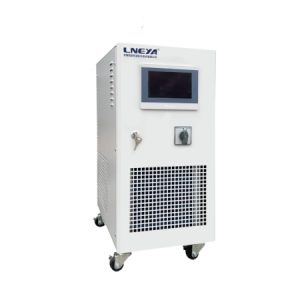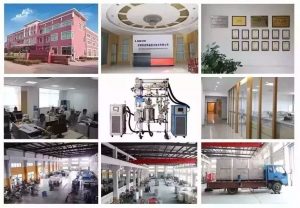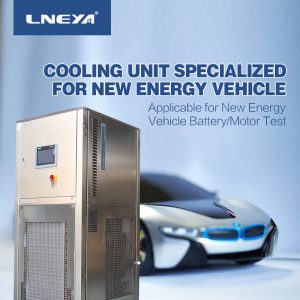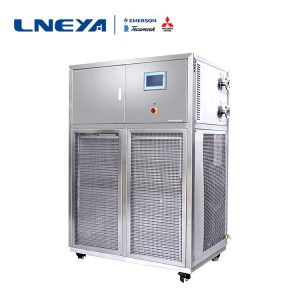Rasterelektronenmikroskop-Kühlwasserkreislaufsystem
Scanning Electron Microscope (SEM) is a high-resolution microscope widely used in materials science, biology, nanotechnology and other fields. SEM generates a certain amount of heat during operation. In order to ensure the stable operation and image quality of the microscope, an efficient cooling water circulation system is required to control the temperature inside the SEM.
The following are the key components and working principles of the cooling water circulation system of the scanning electron microscope: Key components:
- Circulation pump: responsible for promoting the circulation of cooling water in the system to ensure that the cooling water can flow evenly through various cooling points inside the SEM.
- Cooling water tank: stores cooling water, usually contains filters and chemical additives to maintain the purity of cooling water and prevent corrosion.
- Heat exchanger: transfers the heat in the cooling water to the external cooling medium (usually air or water) through the heat exchanger to achieve the purpose of cooling.
- Temperature controller: monitors the temperature of the cooling water and adjusts the temperature of the cooling water through automatic control systems such as PID controllers to ensure that it is stable within the set temperature range.
- Filter: Filter impurities in cooling water to prevent clogging of the cooling system.
- Pipes and valves: Connect various components to ensure that cooling water can circulate smoothly.
Working principle:
- Cooling water circulation: Cooling water flows out of the cooling water tank and enters the cooling channel or cooling plate inside the SEM through the circulation pump to absorb the heat generated inside the SEM.
- Heat exchange: The cooling water that has absorbed heat then flows into the heat exchanger, where the heat is transferred to the external cooling medium through the heat exchanger to achieve cooling of the cooling water.
- Temperature control: The temperature controller continuously monitors the temperature of the cooling water and adjusts the speed of the circulation pump, the flow rate of the cooling water or the working state of the heat exchanger as needed to keep the temperature of the cooling water stable within the set range.
- Circulation reflux: The cooled cooling water returns to the cooling water tank again to prepare for the next cycle.
- Filtration and maintenance: After a period of use, the cooling water needs to be filtered to remove impurities, and the cooling water and chemical additives need to be replaced regularly to keep the system clean and efficient.
Key requirements:
- Temperature control accuracy: It is usually necessary to control the temperature of the cooling water within the range of ±0.5°C to ±1°C to ensure the stability of the temperature inside the SEM.
- Circulation efficiency: Ensure that the cooling water can circulate efficiently to avoid local overheating. • Safety and protection: The system should have safety measures such as over-temperature protection and pressure protection to ensure the safe operation of the equipment.
- Low noise: The circulation pump and heat exchanger should reduce noise as much as possible to avoid interference with the operation of the SEM.
- Maintenance convenience: The design should be easy to maintain and clean to ensure long-term stable operation.
In summary, the cooling water circulation system of the scanning electron microscope ensures the stability of the temperature inside the SEM by accurately controlling the temperature of the cooling water, thereby improving the imaging quality and stability of the microscope.
Verwandte Empfehlungen
-
Welche Prüfungen werden bei Kühlwasserkühlern für neue Energieunternehmen durchgeführt?
1360Im Rahmen der Produktentwicklung, der Produktion und der Qualitätskontrolle führen die Unternehmen der neuen Energiewirtschaft eine Reihe von Tests mit Kaltwassersätzen durch. Kaltwassersätze spielen bei diesen Tests eine wichtige Rolle, um die Leistung zu...
Details anzeigen -
Kühlaggregat Wasserkühlung Kältemaschine
1285Das Kaltwasserkühlsystem ist eine effiziente Kühllösung, die Wärme durch zirkulierendes Kühlwasser abführt. Dieses System wird häufig in Industrie-, Labor- und Gewerbeumgebungen eingesetzt, insbesondere bei Anwendungen, die eine präzise...
Details anzeigen -
What instruments in biopharmaceutical processes require cooling water systems?
1246In biopharmaceutical processes, many critical equipment and instruments require cooling water systems to maintain their normal operation and process temperature control. The following are some common types of equipment that require cooling w...
Details anzeigen -
What is the difference between glycol chillers and water-cooled chillers?
1572Both glycol chillers and chillers can be used to satisfactorily dissipate the heat generated during production. The fundamental difference between the two types of chillers is the variation in their freezing point and heat transfer capabilities. ...
Details anzeigen -
The principle of LNEYA chiller
1625Industrial chillers are commonly used to cool products and machinery for a variety of different applications, including injection molding, tools and die cutting, food and beverage, chemicals, lasers, machine tools, semiconductors and more. In most...
Details anzeigen -
How to choose the accessory pump in the new energy vehicle battery test?
1349New energy vehicle battery testing plays a more important role in the development of new energy vehicles. In the operation process, the pump is the key supporting equipment in the LNEYA test equipment, which is also concerned by people. So how to ...
Details anzeigen -
Beschreibung der Pumpenauswahl im Temperaturregler für dampfgesättigte Systeme
1623Das Temperiergerät für Dämpfungsanlagen ist eines der am häufigsten verwendeten Geräte in der pharmazeutisch-chemischen Industrie. Die Leistung des LNEYA Dampferzeuger-Temperaturreglers hängt von der Konstruktion des gesamten Systems und der Spezifikation des...
Details anzeigen
 LNEYA Industriekühler Hersteller Lieferant
LNEYA Industriekühler Hersteller Lieferant














